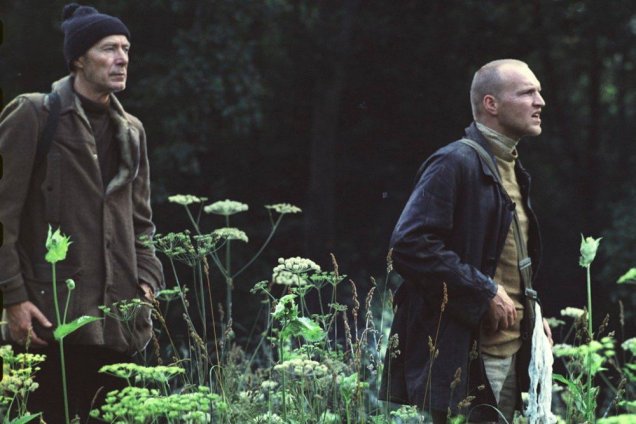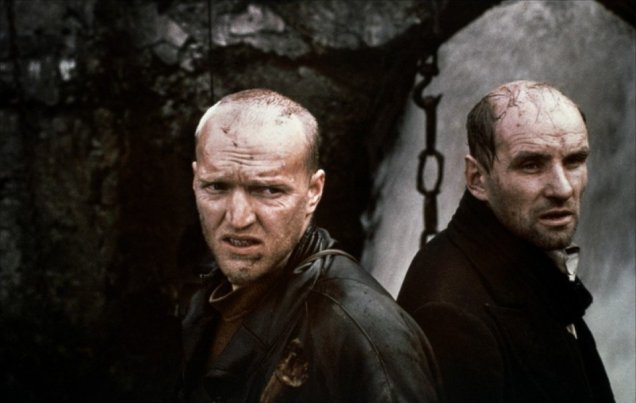As part of my research into how colour is used to conjure up a sense of fear, a feeling of being unsettled or a sense of discomfort, my tutor suggested that I look Andrei Tarkovsky’s 1979 film ‘Stalker’. The film is based on a novel called Roadside Picnic by Arkadii and Boris Strugatsky. In the book there is a place called the Zone which is the site of an alien visitation, its power caused by some kind of residual radiation likened to the debris left behind after a roadside picnic.
The film itself depicts the journey of two men through a no man’s land called the Zone. One is called the ‘Writer’ who seems to be looking for inspiration and the other the ‘Professor’ whose intention is less obvious. They want to reach a temple-like Room at the Zone’s centre which we are given to understand has the ability to grant pilgrims their most cherished desire. We can infer that the Zone is dangerous from its being cordoned off from the rest of the world by barbed wire and surrounded by military forces unwilling to chase after anyone who penetrates the Zone’s perimeter.

The two men are guided on their quest by the ‘Stalker’, a man who appears to have both an intimate knowledge of the Zone and a curious relationship with it. For the Stalker the journey is almost a religious / mystical experience – a coming back to where he feels a sense of peace not found outside the Zone. There is a sense of something unseen but certainly felt by the Stalker. His interpretation of this is channelled into a prescriptive journey tracking through the landscape carefully to avoid ‘traps’ set by the ‘presence’ and ensuring that his two fellow travellers do not damage the land through which they travel and therefore incur the wrath of the Zone.
What was my reaction to the film? It was curious. It took me almost half of the film to tune in to the atmosphere being created and begin to work out what it was that was making me feel uneasy (on behalf of the two ‘newbies’ to the Zone ). Then at the point when I wasn’t sure I wanted to carry on, I inexplicably developed a feeling of needing to carry on to its conclusion to ‘see what happens’. The ending is not climatic in the sense of a thrilling Sci Fi denouement, rather understated and puzzling.
Theories about what the Zone is all about vary from an allegory for the fear of nuclear contamination or ecological disaster to Raymond Bellair’s view,‘an image in which dream is indistinguishable from memory. (Bird). While Slavoj Žižek considers the Zone to be ultimately ‘the material presence, the real of an absolute Otherness incompatible with the rules and laws of our universe’.(Bird).
There is an interesting quote from Tarkovsky in the booklet that accompanies the DVD of the film and a helpful pointer for my assignment. On the subject of what things mean in his films he says:
‘An artist doesn’t have to answer for his meanings. I don’t think so deeply about my work – I don’t know what my symbols may represent. What matters to me is that they arouse feelings, any feelings you like, based on whatever your inner response might be [ my italics]. If you look for a meaning, you’ll miss everything that happens. Thinking during a film interferes with your experience of it. Take a watch to pieces, it doesn’t work. Similarly with a work of art, there’s no way it can be analysed without destroying it’
So what was going on here…by this I don’t mean the storyline but where did the feeling of unease come from? And is there

anything that I can adapt to use for my underpass images? Did what I was experiencing come from the use the music, the lighting, the setting, the acting/ characterisation or the use of colour (or not)? The film was shot in a mix of black and white and colour.Black and white was used for the world outside the Zone where a sense of grimness and desolation came from an industrialised landscape and run down interiors barely seen in the darkening gloom. For the most part though, the Zone was filmed in colour. This intermingling of colour and monochrome was intentional and not because a laboratory processing error meant that the film had to be shot twice. Though Tarkovsky loved black and white cinema, he acknowledged that audiences tended to prefer colour. That said, he believed colour to be less realistic hence using monochrome for the ‘real’ images on the film. The greenness of the resurgent countryside within the Zone is an obvious contrast to ‘outside’ world.
But to my mind this normal green landscape links closely to Freud’s idea of the uncanny being the feeling of discomfort when seeing something that is simultaneously familiar and alien. You see grass and trees that look perfectly normal but how does this seem in relation to the destroyed buildings and dead army personnel sat in their vehicles amongst the undergrowth. Is this familiar expression of nature natural or normal? The evolving feeling that this normal looking countryside within the Zone is alien comes from a different quarter; the behaviour of Stalker; the silent and empty landscape (well almost) ; the grim dereliction of buildings, pools of water and scattered debris such as syringes and calendar pages.
More importantly, it comes from the filming – close-ups dipped in sepia-toned bronzes; some cast in harsh morning light, some obscured by dank, dark shadows.

Nick Schager describes the standard setups juxtaposed with disorientating pans, zooms and reverse zooms as ‘ creating an impression of what’s left unseen outside the pictures edges’. Now this is interesting. I pick up here on the use of disorientating pans as this is something that I am already experimenting with, in wanting to catch a sense of something unseen or felt rather than seen:

Now I am also thinking of the ‘colour’ of the mood that I am trying to convey visually…in Stalker, it’s a mix of sepia tones, harsh morning light and dark shadows…can I use any of this for my underpass images?
References
Bird,R. (2017) Stalker’s curse [online] Tiff website. Available from:https://www.tiff.net/the-review/stalkers-curse/ Accessed: 26 March 2018
Schager,N. (2006) Stalker [online] Slantmagazine Website. Available from: https://www.slantmagazine.com/film/review/stalker Accessed 26 March 2018
Stalker [feature film,DVD] Dir. Andrei Tarkovsky. Mosfilm,Unit 4,1979. 161mins. [Curzon Film World Limited, Art793, 2016]
Strick,P. (2016) Tarkovsky’s Translations. Stalker DVD booklet. pp.8-31